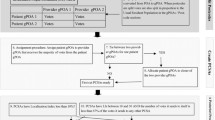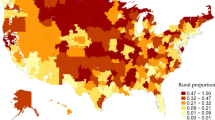Abstract
Primary health care utilization is poorly understood in many parts of the developing world. This is especially true in rural places, such as Santa Lucia, Intibuca, Honduras, where there are only three primary health care facilities servicing almost 12,000 people, and generally speaking access to care is limited. This study examines the factors that can be used to explain primary health care utilization, and aims to improve the understanding of patient utilization behavior. A better understanding of utilization can be used by health service planners to improve primary health care delivery in this and similar locations. The findings of this research indicate that utilization can be explained, to a large extent, by factors relating to economic status and walking time to clinic. These findings are consistent with findings from prior research. In addition, a home territory variable is used to examine spatial variations of utilization behavior. This variable has not been considered in previous utilization research, and is found to be a very significant determinant of health facility utilization in the study area.
Similar content being viewed by others
References
Andersen, R. (1968). A behavioral model of families’ use of health services, research series no. 25. Chicago: Center for Health Administration Studies.
Andersen, R., & Newman, J. (1973). Societal and individual determinants of medical care utilization in the United States. Milbank Memorial Fund Quarterly, 81, 95–123.
Andersen, R. M. (1995). Revisiting the behavioral model and access to medical care: Does it matter? Journal of Health and Social Behavior, 36, 1–10.
Anderson, D. W., & Andersen, R. M. (1972). Patterns of use of health services. In H. Freeman, S. Levine, & L.␣Reeder (Eds.), Handbook of medical sociology. (2nd ed.) Englewood Cliffs, New Jersey: Prentice-Hall. Cited from Joseph and Phillips (1984).
Bailey, W. & Phillips D. R. (1990). Spatial patterns of use of health services in the Kingston Metropolitan Area, Jamaica. Social Science and Medicine, 30(1), 1–12.
Benarroch, M., & Grant, H. (2004). The interprovincial migration of Canadian physicians: Does income matter? Applied Economics, 36, 2335–2345.
Black, M., Steeve, E., Aguilar, P. N., Vidaurre, M., & El Morjani Z. (2004) Using GIS to measure physical accessibility to health care. ESRI 2004 International Health Conference Proceedings.
Buor, D. (2002). Distance as a predominant factor in the utilisation of health services in the Kumasi metropolis, Ghana. GeoJournal, 56, 145–157.
Buor, D. (2003). Analysing the primacy of distance in the utilization of health services in the Ahafo-Ano South district, Ghana. International Journal of Health Planning and Management, 18, 293–311.
Buor D. (2004) Determinants of utilisation of health services by women in rural and urban areas of Ghana. GeoJournal, 61(1), 89–102
Cleary, P. D., Mechanic, D., & Greenley J. R. (1982). Sex differences in medical care utilization: An empirical investigation. Journal of Health and Social Behavior, 23, 106–119.
Daniell, G., & Smith S. (2003). AMC white mountain guide. (27th ed.) New Hampshire: Appalachian Mountain Club Books.
Diehr, P., Yanez, D., Ash, A., Hornbrook, M., & Lin D. Y. (1999) Methods for analyzing health care utilization and costs. Annual Review of Public Health, 20, 125–144.
Duong, D. V., Binns, C. W., & Lee, A. H. (2004). Utilization of delivery services at the primary health care level in rural Vietnam. Social Science & Medicine, 59, 2585–2595.
Egunjobi, L. (1983). Factors influencing choice of hospitals: A case study of the northern part of Oyo State, Nigeria. Social Science and Medicine, 17, 585–589.
Habib, O. S., & Vaughan J. P. (1986). The determinants of health services utilization in Southern Iraq: A household interview survey. International Journal of Epidemiology, 15, 395–403.
INE. (2004). Instituto Nacional de Estadistica. Tegucigalpa, Honduras, C.A. The Honduras 2001 National Census. Downloaded from: http://www.ine-hn.org/
Johnston, R. J., Gregory, D., Pratt, G., & Watts, M. (Eds) (2000). The Dictionary of Human Geography. (4th ed.) Oxford: Blackwell Publishers Ltd.
Jones, K., & Simmons, J. (1990). The retail environment. London: Routledge.
Joseph, A. E., & Phillips, D. R. (1984). Accessibility & utilization: Geographical perspectives on health care delivery. London: Harper &Row Ltd.
Kohn, R., & White, K. L. (Eds) (1976). Health care: An international study. Oxford: Oxford University Press.
Koos, E. (1954). The health of regionsville. New York: Columbia University Press. Cited from Joseph and Phillips, 1984.
Kroeger, A. (1983). Anthropological and socio-medical health care research in developing countries. Social Science and Medicine, 17, 147–161.
Love, D., & Lindquist, P. (1995). The geographical accessibility of hospitals to the aged: A geographic information systems analysis within Illinois. Health Services Research, 29, 629–651.
Meade, M. S., & Earickson, R. J. (2000). Medical geography. (2nd ed.) New York: The Guilford Press.
Müller, I., Smith, T., Mellor, S., Rare, L., & Genton, B. (1998). The effect of distance from home on attendance at a small rural health centre in Papua New Guinea. International Journal of Epidemiology, 27, 878–884.
Noor, A. M., Zurovac, D., Hay, S. I., Ochola, S. A., & Snow R. W. (2003). Defining equity in physical access to clinical services using geographical information systems as part of malaria planning and monitoring in Kenya. Tropical Medicine and International Health, 8(10), 917–926.
Perry, B., & Gesler, W. (2000). Physical access to primary health care in Andean Bolivia. Social Science and Medicine, 50, 1177–1188.
Powell, M. (1995). On the outside looking in: Medical geography, medical geographers and access to health care. Health and Place, 1, 41–50.
Ricketts, T. C. (2002). Geography and disparities in health care. In Guidance for the National Healthcare Disparities Report, National Academy of the Sciences.
Seo, K. (1976). Some determinants of the health service utilization and health care expenditure in rural families. Korea: Department of Public Health, Yonsei University.
SERNA-Secretaria de Estado en los Despachos de Recursos Naturales y Ambiente. 2005. GIS boundary shape files acquired for the 2001 Honduran National Census. Tegucigalpa.
Shoulder-to-Shoulder. 2005. Website accessed May 22, 2005.http://www.shouldertoshoulder.org
Stock, R. (1983). Distance and the utilization of health facilities in rural Nigeria. Social Science Medicine, 17(9), 563–570.
Stouffer, S. A. (1940). Intervening opportunities: A theory relating mobility and distance. American Sociological Review, 5(6), 845–867.
Tanser, F., Hosegood, V., Benzler, J., & Solarsh, G. (2001). New approaches to spatially analyse primary health care usage patterns in rural South Africa. Tropical Medicine and International Health, 6(10), 826–838.
Wolfe, B. (1999). Poverty, children’s health, and health care utilization. FRBNY-Economic Policy Review. Federal Reserve Bank of NY. September, 1999.
Acknowledgements
The authors are grateful to the following individuals and institutions for their support of this research: Howard Stafford, Andrew Bazemore, Jeff Heck, Chris Carr, Miguel Coello and the staff of Shoulder-to-Shoulder, Inc. and la Clinica Hombro á Hombro. La Secretaria de Estado en los Despachos de Recursos Naturales y Ambiente (SERNA), for making GIS and Honduran Census data files available for use in this project. University of Cincinnati for their financial support of this research through the Graduate Student Governance Association (GSGA); the Institute for Global Studies and Affairs (IGSA); and the University Research Council (URC). Part of this material is based upon work supported by the National Science Foundation under Grant No. IIS-0081434. Any opinions, findings, and conclusions or recommendations expressed in this material are those of the author(s) and do not necessarily reflect the views of the National Science Foundation
Author information
Authors and Affiliations
Corresponding author
Rights and permissions
About this article
Cite this article
Baker, J.B., Liu, L. The determinants of primary health care utilization: a comparison of three rural clinics in Southern Honduras. GeoJournal 66, 295–310 (2006). https://doi.org/10.1007/s10708-006-9001-8
Received:
Accepted:
Published:
Issue Date:
DOI: https://doi.org/10.1007/s10708-006-9001-8




